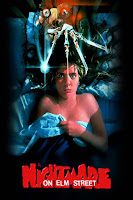This is a series I’m a little
reluctant to deal with, because my view of the franchise is so at
odds with the rest of the horror community.
Don’t get me wrong, I love the original A Nightmare on Elm Street. However, I find the (usually despised) Freddy’s Revenge, and Freddy vs Jason to be the only enjoyable sequels. I feel that Dream Warriors, (typically regarded as the second best in the series,) turned it from horror franchise into an unusually violent Saturday-morning cartoon. And the series remained exactly that until FvJ.
Don’t get me wrong, I love the original A Nightmare on Elm Street. However, I find the (usually despised) Freddy’s Revenge, and Freddy vs Jason to be the only enjoyable sequels. I feel that Dream Warriors, (typically regarded as the second best in the series,) turned it from horror franchise into an unusually violent Saturday-morning cartoon. And the series remained exactly that until FvJ.
The premise of the film is well known
by now. Years before the film is set, Freddy Krueger (Robert
Englund) was a child-killer who was set free on a technicality. The
parents of his victims hunted him down and burned him alive. So now,
the surviving children of the parents who killed him are being
attacked in their dreams, and are somehow dying real and bloody
deaths.
For me at least, Englund’s
performance as Freddy is easily the best thing about this film. The
idea of being attacked in my sleep doesn’t bother me that much
personally, as nightmares usually wake me up instantly. However, the
idea of being under assault by Robert Englund, armed with razor-sharp
claws, is unnerving.
The kids are, for the most part,
well-acted. Our decoy protagonist, Tina (Amanda Wyss), is killed
fairly early in the film, with Freddy framing her boyfriend Rod (Jsu
Garcia), before killing him in his jail cell. The movie then shifts
to Nancy (Heather Langenkamp), assisted by her less-than-competent
friend Glen (Johnny Depp).
Langenkamp gives the best performance
of the film after Englund himself, making us believe that she’s
someone who can stay rational under fire. I am a little confused by
why Freddy let her live so much longer than the others, but I'm
certainly happy for it. (The remake made it clear he had molested
all of them and was the most obsessed with her; one of the few
positive changes.) I don’t think any of the other actors could
have carried the confrontation with the same level of intensity.
Nancy eventually determines that it’s possible to bring things from
the dream world into the real world by grabbing onto them, so she
attempts to go into the dream and drag Freddy out into the real world
where he can be killed.
If the movie has a weak point, it’s
John Saxon as Nancy’s father, Lt. Don Thompson. The movie clearly
wants to emphasize that this is a coming-of-age story by showing him
to be both an overprotective father, and a completely useless cop.
He nearly shoots Rod for being near his daughter, but is reluctant to
go to her when she has Freddy trapped in a bedroom and is screaming
for help.
Nancy’s mother (Ronee Blakely)
establishes the element of the protective but incapable parent far
more effectively. She provides exposition, telling us the full
story, and assuring her daughter of Freddy’s demise. She also
shows us how her guilt over killing Krueger drove her to drink.
Furthermore, unlike her husband, she recognizes that something
strange is going on, even as she denies that Freddy could strike out
from beyond.
The end of the movie was changed at the
last minute by executive mandate. Nancy denies Freddy’s existence,
and the entire film is revealed to be a dream. Freddy’s victims
are alive again, and Nancy’s mother is giving up drinking. But
then, when Nancy gets into a car with her friends, the car turns out
to be possessed by Freddy, and he shows up to kill her mother. The
whole “Happy Ending” was just a moment of hope created by the
invincible Freddy.
Craven wanted the film to end on a
happy note, with Freddy unambiguously defeated, and claims that the
change was made to allow for sequels. However, the producer disputes
this claim, saying that he felt that the original ending was simply
boring, and that the final shock was a way of going out on a high
note. I’m actually on the side of the executives in this case,
because ending such a dark movie with everyone coming back to life
and everything being perfect would have felt like bad parody.
We could debate the quality of the
sequels until the end of time. However, the original incarnation of
Freddy Krueger is an icon of horror. The only other horror icon who
is so brought to life purely by the performance of his actor is
Pinhead (Doug Bradley) from the Hellraiser series. And I
don’t think there’s a horror fan out there who doesn’t get
creeped out when they hear the words “One, two, Freddy’s comin’
for you.” This is a performance that will long outlive its actor.








